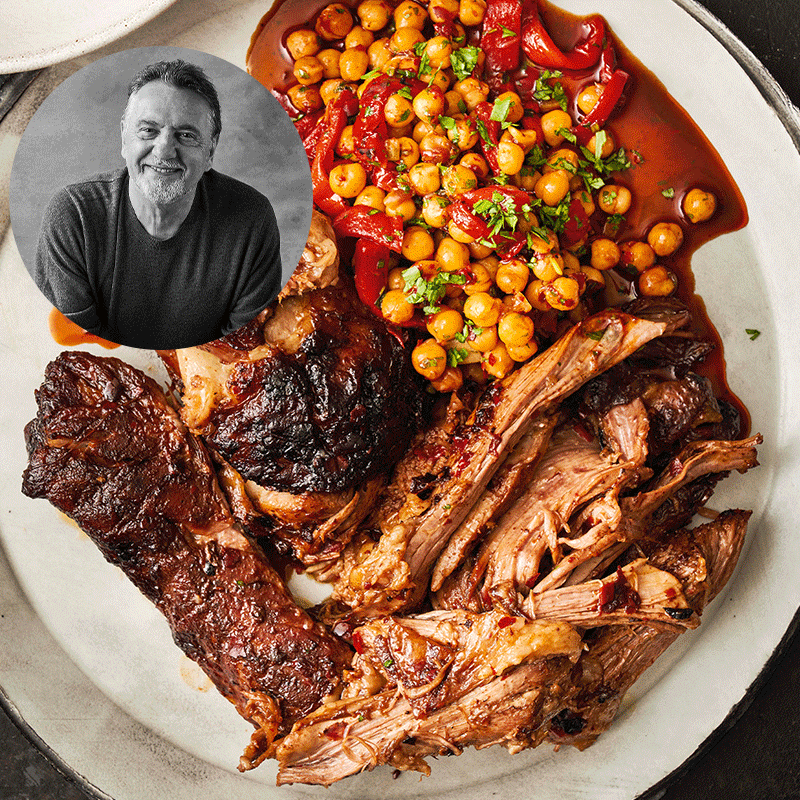How To Cook Meat Well – With Raymond Blanc
In March 2020, the UK went into lockdown and I started to wonder about how the world was about to change. The coronavirus pandemic was here. Convenience vanished. Shopping for food became difficult. The culture of the sandwich at the office desk was no more. The shops that made sandwiches were closed, and offices with the desks were shut. Most of us stayed at home, though millions continued as key workers, and to them, we shall always be indebted.
On my own, and in my flat in London, I would call my mum in France. A woman of less than five feet, she had never let her lack of height get in the way of a good meal. I found myself craving, and then cooking, childhood meals that were simple to make and full of goodness. All of them could be rustled up speedily: tartiflette, a plate of crudités, a morteau sausage salad, an onion or tomato soup – and the one that my mother made with the season’s vegetables and chervil, when I was her young helper and runner.
Since 1984 I have spent so much of my time in the kitchens at Le Manoir aux Quat’Saisons and Brasserie Blanc, but my professional life became a struggle, filled with tremendous stress and strains; the turmoil of a business put on hold. Slowly, however, I began to really relish the fun that comes from cooking at home. I took to social media, sharing recipes that my British friends would call ‘easy peasy’.
As the weeks of solitude progressed, it was as if we had been ‘given’ more time. We devoted this time to the garden (the weather was glorious), to yoga, puzzles, TV boxsets. And the cooks among us spent that extra time in the kitchen. The fast, fast world in which we lived had stopped zooming along, and was now in slow motion. The hurried breakfast bowl of cornflakes made way for the deep, rich scents of freshly baked banana loaf. The cheap burger on the hop was replaced by the cheerful barbecue in the garden. People spoke of finding positives in this new climate of negatives and, for those of us who love to cook, we did not need to search too far for pleasure.
The pandemic has helped us understand the impact of our lifestyles and the food we eat. I think we will now seriously tackle food waste, and we will be closer to our farmers, butchers, fishmongers, cheesemakers and our other food producers. We need to reconnect more with seasonality, and the provenance and authenticity of produce. Sustainability must be the driving force in the years to come, and we will rediscover our skills. We will grow more and import less, which will be good for the farmers and the economy. By digging into the past, we shall find our future. Maybe I am just an old romantic, but I do believe this will happen.
Inspired? Here are four of Raymond’s great, easy recipes to try…
Pan-Fried Pork Chops & Steamed Kale With Apple Sauce
This is a multitask dish. The five-minute apple sauce is fresh-tasting and nutritious. Meanwhile, the pork chops are placed into the hot pan when the butter is foaming and just about to turn brown. That way, the chops will cook – slowly, slowly – to a dark amber colour, and the juices will stick to the pan. These, with the addition of water, will give you the most marvellous jus.
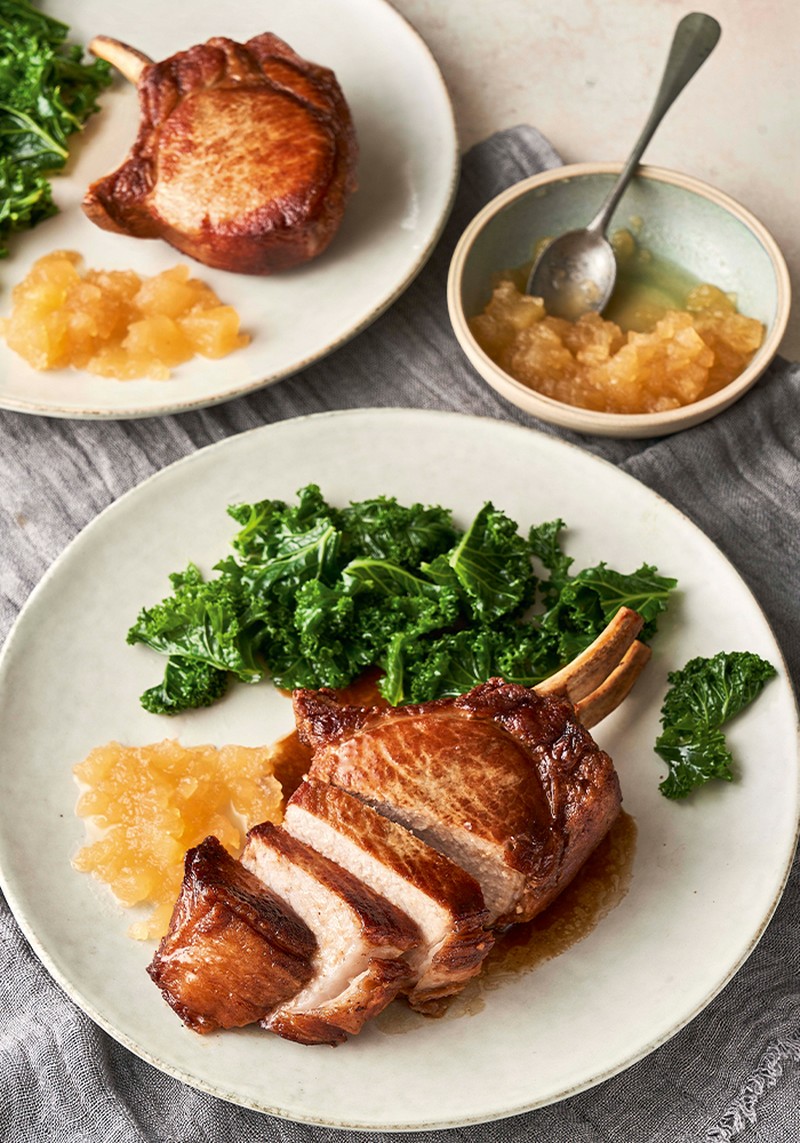
First, the apple sauce. Peel and core the apples, and chop them into pieces of about 2cm.
In a medium saucepan with a lid and on a medium heat, cook the apple pieces in the water for 6–8 minutes, stirring occasionally, until the apple pieces are soft enough to be broken with the back of a fork. Remove the pan from the heat and leave the sauce to cool until ready to serve. It can be blended to a purée or left as it is, with more texture than a purée.
While the apple sauce is cooking, put the kale in a medium-sized saucepan, add the water, season with the salt and place the butter on top of the kale. Cover the pan with a lid, and leave it for now.
Next, season the pork chops with the salt and pepper. In a large frying pan, and over a medium heat, melt the butter and when it is foaming (at the beurre noisette stage) add the thyme sprigs and place the pork chops in the pan. Cook the chops for 7 minutes on each side, until beautifully golden and appetising.
After you have turned the chops, start to cook the kale. Put the kale pan, covered with a lid, on a high heat. Very quickly the kale begins to steam and it will take 3–4 minutes to cook. Drain the kale, and taste for seasoning.
In the final minute of the chops frying, pour the water into the hot pan. Sizzle, sizzle, sizzle – don’t you simply love the reassuring sound of near-completion!
Divide the steamed kale between the two plates, place a chop on top, and spoon the hot pan juices over the chop. Serve with the apple sauce.
Slow-Roasted Shoulder Of Lamb With Harissa
When I was about 12 years old, I was introduced to the food of Algeria, and by strange means. This was during the Algerian War, and in France there were camps for Algerian refugees. One such camp was close to my village and, with my friend René, I would go and visit these intriguing, kind and friendly people. They fed us well. I remember seeing whole lambs roasted on the spit and, as the meat was turned, it was also painted with the spicy juices. This dish does not require a whole lamb. When it comes to slow cooking lamb, the shoulder is the best cut, meltingly tender and incredibly tasty. When harissa is added, this is a wonderful dish, and the chickpeas will only complement it. A shoulder of lamb varies in weight, becoming heavier as the year progresses. A 2.5kg shoulder, like the one in this recipe, will take about 4½ hours; one weighing 3kg will need 5½ hours. Aim to remove it from the fridge 4–5 hours before cooking to come to room temperature.
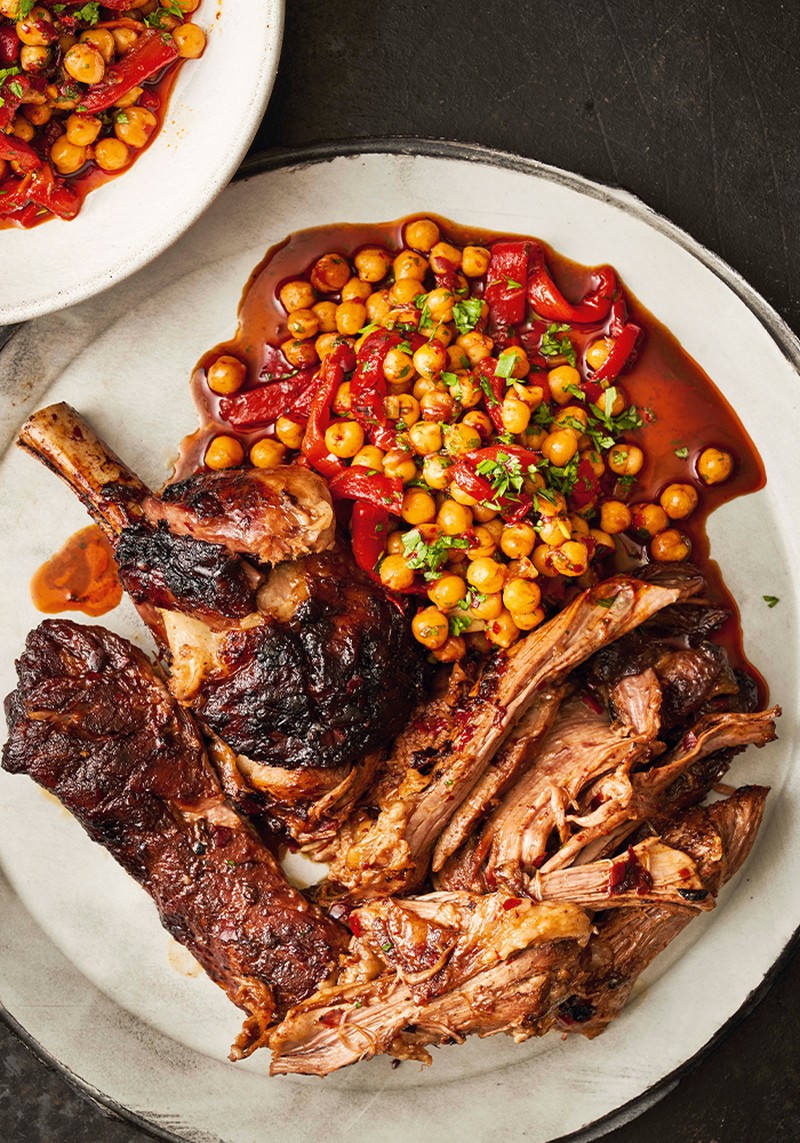
Mix together the salt, cumin and harissa, then add the extra-virgin olive oil. Place the lamb in a roasting tin. Lightly score the skin of the lamb and rub it all over with the salty harissa mixture. At this point, you can leave the lamb for an hour, allowing the harissa flavours to infuse, but this is not essential.
Preheat the oven to 180°C/160°C fan/gas 4. Roast the lamb for 20 minutes, then reduce the temperature to 150°C/130°C fan/gas 2. Cover the lamb shoulder loosely with foil, and return it to the oven to roast for a further 2 hours.
Now baste the lamb, add the water and return it to the oven for 2 hours, again loosely covered with foil.
While the lamb is roasting, chop the piquillo peppers, finely chop the preserved lemons (skin and pulp) and coarsely chop the parsley. Put them to one side; you will need them to finish the dish.
Remove the lamb from the oven. Spoon out most of the fat from the tin, leaving the roasting juices. To the warm roasting juices, add the chickpeas, peppers and lemon. Add the parsley too and season with the salt and pepper. Toss together and bring to the boil on the hob.
Place the lamb shoulder on a platter with the chickpea salad. Bring the lamb to the table and invite your guests to help themselves. The lamb will be tender enough to fall from the bone with a spoon, though it can be carved if you prefer.
Steak Maman Blanc & Steak With Red Wine Jus
Here are two recipes for pan-fried steak, which was a monthly treat in my childhood home. Steak Maman Blanc is named after my mother because she cooked the steak just like this, extracting the flavours of the meat and the herbs, then adding a little water at the end to create the most delectable, perfumed jus. It’s phenomenal! Then there is Steak with Red Wine Jus, which is also quick and, perhaps, for a more special moment. The ideal accompaniment? Sautéed potatoes and bacon.
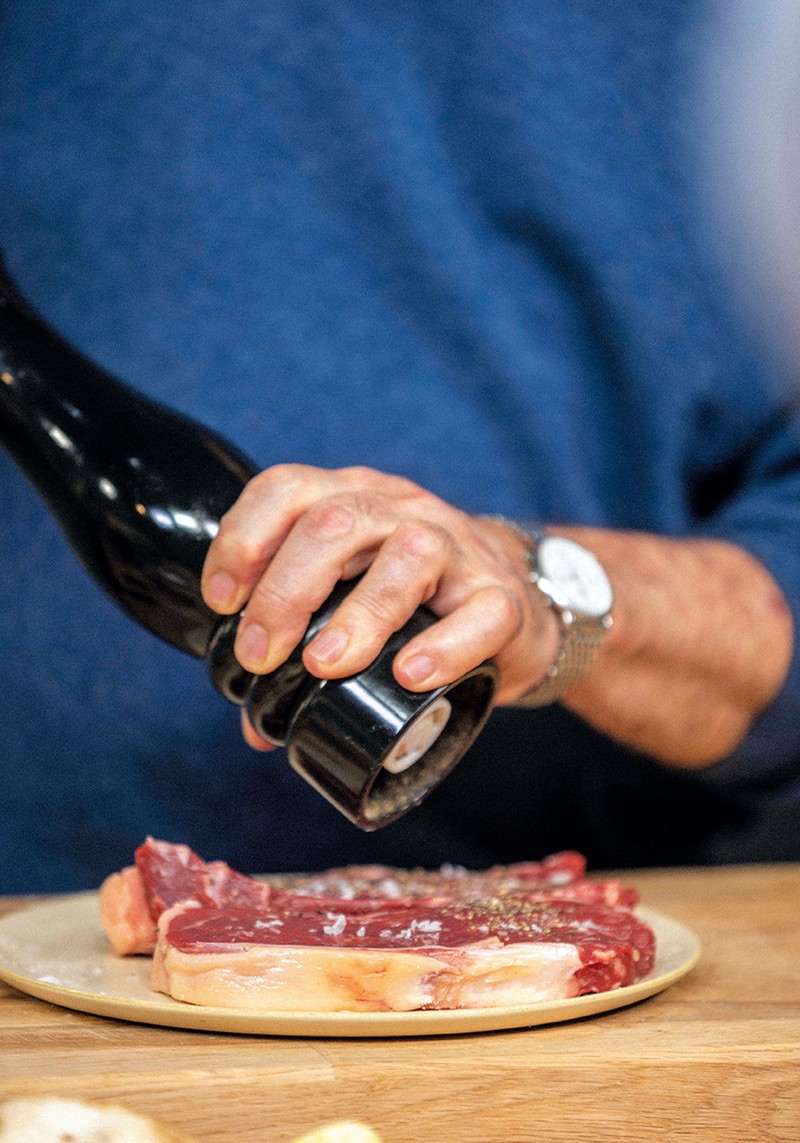
Remove the steaks from the fridge at least 30 minutes before cooking. Season each side of the steaks with the salt and grind the black pepper over them – be generous with it. Firmly press the salt and pepper into the steaks.
On a medium heat, in a large frying pan, put the butter and let it melt and foam. Then, when the butter starts to turn light gold and nutty, you know the heat is just right to sear and slowly brown the meat. Now is the time to lay the steaks into the butter and increase the heat to medium-high to keep things nice and hot. FOR RARE: Cook 1 minute on each side. FOR MEDIUM-RARE: Cook for 2 minutes on each side. FOR MEDIUM: Cook for 3 minutes on each side, turning twice.
When you turn the steaks, keep each of them in the same spot in the pan. To test if the steak is cooked to your liking, press the meat with your forefinger. For rare, it should be soft and your finger will not leave an imprint; medium will feel quite firm, because the fibres will be cooked.
Using tongs, transfer the steaks to a warm plate. Put the pan back on a medium-high heat and pour the water into the hot pan – sizzle, bubble, boil. The butter and water will create an emulsion. Scrape the base of the pan with a spatula or wooden spoon to release the caramelised residue, adding flavour and colour to this succulent juice. Pour the juice on to the steaks and serve immediately with the sautéed potatoes.
Steak With Red Wine Jus
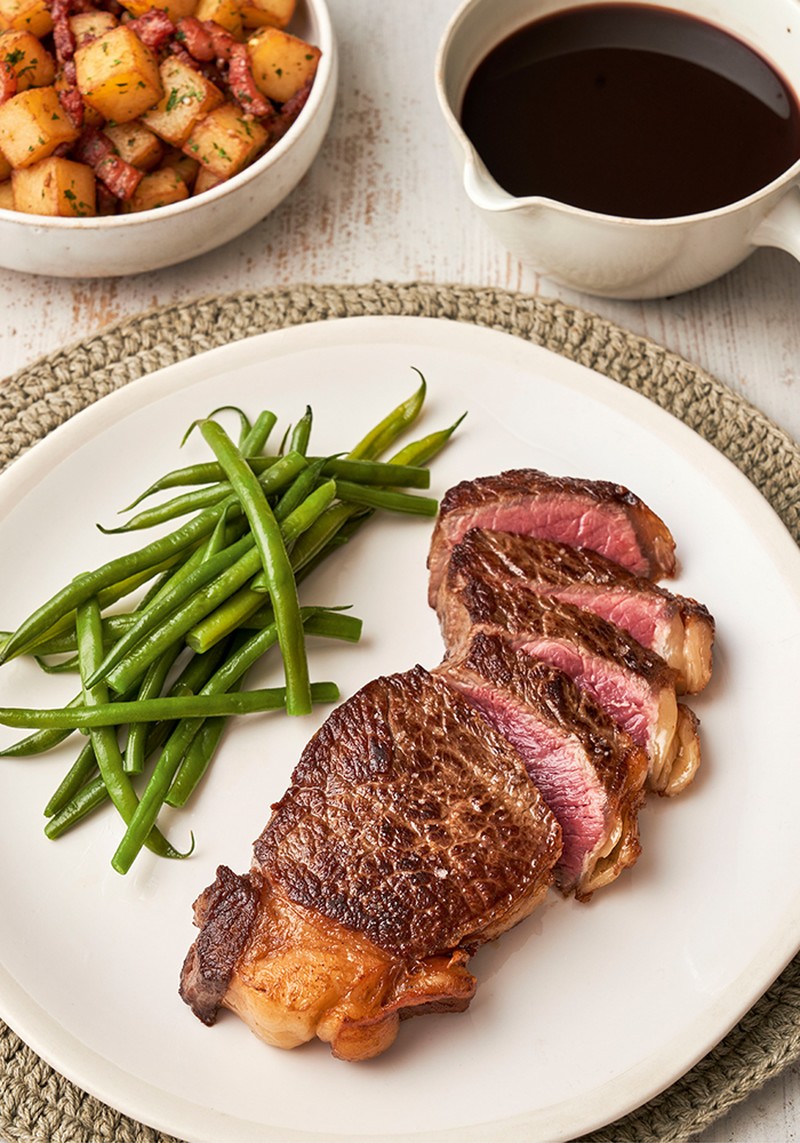
Finely chop the shallot. Wash the mushrooms by swirling them for 10 seconds in a bowl of cold water. Drain them, pat dry with kitchen paper and dice. Finely chop the parsley by rolling it and chopping with its stalks. Open the bottle of wine and, yes, taste.
Follow the same preparation and cooking method as for Steak Maman Blanc (see above), seasoning and cooking in 40g of the butter. However, when you remove the steaks from the pan, place the pan back on a medium-high heat and add the shallot and mushroom. Cook for 1 minute then pour in the red wine and reduce by half. Whisk in the remaining 20g of cold butter. Taste and correct the seasoning.
Spoon the mushrooms over each steak, pour the red wine jus on top and sprinkle over the parsley, if using. Serve with sautéed potatoes.
Simply Raymond: Recipes from Home by Raymond Blanc is published by Headline Home, £25. Photos: Chris Terry
DISCLAIMER: We endeavour to always credit the correct original source of every image we use. If you think a credit may be incorrect, please contact us at [email protected].
